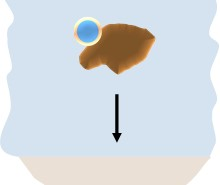Settling velocity of a particle
Settling is the process by which particulates settle to the bottom of a liquid and form a sediment. Settling velocity (\(v_{p}\), m/s) describes the rate at which a particle moves through the liquid either due to gravity or due to centrifugal force.
|
\(v_{p}=\frac{2}{9}\frac{\rho_{p}\rho _{f}}{\mu }gR^{2}\) \(g\) - gravitational acceleration (m/s2) \(R\) - radius of the spherical particle \(\rho _{p}\) - mass density of the particles (kg/m3) \(\rho _{f}\) - mass density of the fluid (kg/m3) \(\mu\) - dynamic viscosity
|
The settling velocity increases with higher density difference of the particles to water of the particles, larger size (size times density difference in boyant mass) and lower water viscosity. |
Execution
Settling velocity can be calculated based on the parameters of the medium used for the experimental setup and physical characteristics of the particles.
Used in
Read more |
Read also |
|
Consult the NanoFASE Library to see abstracts of these deliverable reports: |
|
Contact
 Frank von der Kammer
Frank von der Kammer
University of Vienna, Austria
Email: frank.von.der.kammer@univie.ac.at

